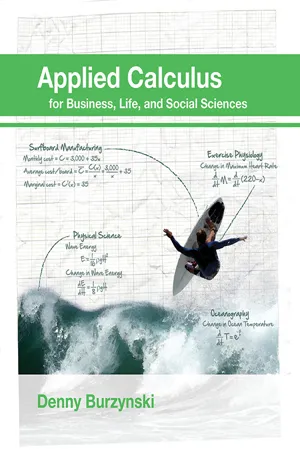Mathematics
Average Value of a Function
The average value of a function over a given interval is the total accumulated value of the function over that interval divided by the length of the interval. It represents the constant value that the function would need to have over the interval to give the same total value. This concept is commonly used in calculus and real analysis.
Written by Perlego with AI-assistance
Related key terms
1 of 5
3 Key excerpts on "Average Value of a Function"
- eBook - PDF
Calculus
Resequenced for Students in STEM
- David Dwyer, Mark Gruenwald(Authors)
- 2017(Publication Date)
- Wiley(Publisher)
Instead, we take an approach that is very similar to what we did for areas under curves in Chapter 5. Suppose we wish to compute the Average Value of a Function y = f (x) over an interval [a, b]. It may be helpful to think of f as representing temperature and [a, b] as a time interval. We begin by dividing the interval [a, b] into n equal subintervals of width Δx = (b - a)/n. We next chose sample points x 1 , x 2 , . . . , x n in each interval. Think of these as times at which temperature readings are taken. The average of the function values (the temperature readings) f (x 1 ), f (x 2 ), . . . , f (x n ) is ¯ f n = f (x 1 ) + f (x 2 ) + · · · + f (x n ) n If we multiply and divide ¯ f n by b - a, we have ¯ f n = 1 b - a [f (x 1 ) + f (x 2 ) + · · · + f (x n )] b - a n Multiplying and dividing by b - a = 1 b - a [f (x 1 ) + f (x 2 ) + · · · + f (x n )]Δx Using Δx = (b - a)/n = 1 b - a n X i=1 f (x i )Δx (7.1) 400 CHAPTER 7. APPLICATIONS OF INTEGRATION By taking n to be larger, we can compute the average value for larger collections of samples taken from smaller intervals. By recognizing the sum in (7.1) as a Riemann sum, and by taking the limit as n → ∞, we obtain lim n→∞ ¯ f n = 1 b - a lim n→∞ n X i=1 f (x i )Δx = 1 b - a Z b a f (x) dx provided the limit exists. This leads to the following definition. The Average Value of a Function If f is integrable over [a, b], then the average value of f over [a, b] is ¯ f = 1 b - a Z b a f (x) dx If f is a positive function over [a, b], then the average value of f has an interesting geometric interpretation. Note that ¯ f satisfies (b - a) ¯ f = Z b a f (x) dx This implies that (b - a) ¯ f is equal to the area under f from x = a to x = b. Thus, ¯ f can be thought of as the height of a rectangle of width b - a that has the same area as the region below the graph of f over [a, b]. - eBook - PDF
Applied Calculus
for Business, Life, and Social Sciences
- Denny Burzynski(Author)
- 2014(Publication Date)
- XYZ Textbooks(Publisher)
I began to really focus in my studies. I wanted to do well in school, and most important I wanted to improve my English. To this day I always reflect to that quote when I feel I can’t do something. I was able to finish junior high successfully. Going to high school was a lot easier and I ended up with very good grades and eventually I was accepted to an excellent college. I was never the smartest student on campus, but I always did well because I never quit. I earned my college degree and now I teach at a dual immersion elementary school. I have that same quote in my classroom and I constantly remind my students to never stop trying. 7.7 7.7 The Average Value of a Function 657 The average, as we normally use it, is a measure that describes the middle of a set of data values. In this section we extend the concept of average to functions of one and two variables. We develop the average value geometrically and then examine a problem in which the average value of the function offers useful information. Average Value of a Function of One Variable Suppose that the function displayed in Figure 1 represents a person’s wealth, f (t), at time t (in years from 2008). We could use the definite integral a b f (t) dt as an accumulator to determine the wealth this person accumulated between years a and b. We could also ask, what is this person’s average wealth over these (b − a) years? You probably know that the average of a discrete collection of numbers is the sum (accumulated value) of those numbers divided by the number of numbers. That is, to determine the average value of the numbers y 1 , y 2 , y 3 , … , y n , you would compute Average = y 1 + y 2 + y 3 + … + y n ___________________ n To determine the average value of a continuous function on some interval [a, b], we make a similar computation. Choose n evenly spaced values of x in [a, b], say, x 1 , x 2 , x 3 , … , x n , and compute their corresponding output values f (x), say, f (x 1 ), f (x 2 ), f (x 3 ), … , f (x n ). - eBook - PDF
- Geoffrey Berresford, Andrew Rockett(Authors)
- 2015(Publication Date)
- Cengage Learning EMEA(Publisher)
Intuitively, the average should represent a “leveling off” of the curve to a uniform height, the horizontal line shown on the left. This leveling should use the “hills” to fill in the “valleys,” maintaining the same total area under the curve. Therefore, the area under the horizontal line (a rectangle with base b 2 a and height up to the line) must equal the area under the curve (the definite integral of the function). ( b 2 a ) a Average height b 5 # b a f ( x ) dx Area under line Area under curve Therefore: a Average height b 5 1 b 2 a # b a f ( x ) dx Dividing by ( b 2 a ) This formula gives the average (or “mean”) value of a continuous function on an interval. y x b b H11002 a a average height f ( x ) Equating the two ways of finding the area 5.4 Further Applications of Definite Integrals: Average Value and Area Between Curves Average Value of a Function a Average value of f on [ a , b ] b 5 1 b 2 a # b a f ( x ) dx Average value is the definite integral of the function divided by the length of the interval Finding the Average Value of a Function by integrating and dividing by b 2 a is analogous to averaging n numbers by adding and dividing by n (since integrals are continuous sums). It also has the advantage of taking account of all of the values of the function in the interval. A derivation of this formula by Riemann sums is given at the end of this section. Copyright 2016 Cengage Learning. All Rights Reserved. May not be copied, scanned, or duplicated, in whole or in part. Due to electronic rights, some third party content may be suppressed from the eBook and/or eChapter(s). Editorial review has deemed that any suppressed content does not materially affect the overall learning experience. Cengage Learning reserves the right to remove additional content at any time if subsequent rights restrictions require it. 346 Chapter 5 Integration and Its Applications Be Careful When finding an average value, it is a common mistake to forget to divide by b 2 a .
Index pages curate the most relevant extracts from our library of academic textbooks. They’ve been created using an in-house natural language model (NLM), each adding context and meaning to key research topics.


